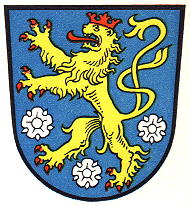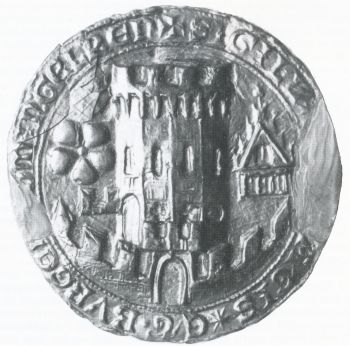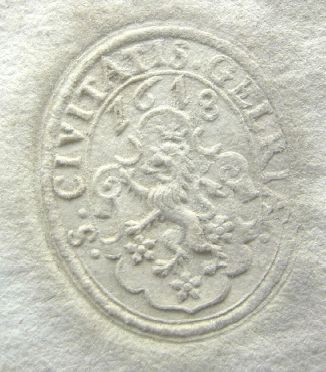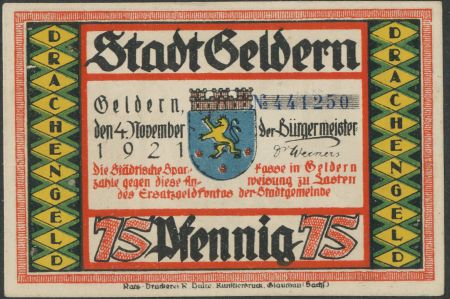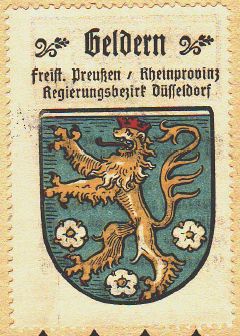Geldern: Difference between revisions
Knorrepoes (talk | contribs) (Created page with '{|width="100%" style="color:black; background-color:#ffffcc;" |width="15%"|50 px|left |width="70%" align="center" |'''Heraldry of the World<br/>Civic heraldr…') |
Knorrepoes (talk | contribs) No edit summary |
||
| Line 36: | Line 36: | ||
The lion of Geldern can be seen in many arms of cities and municipalities in the former Duchy, like in the arms of [[Venlo]], [[Zutphen]], [[Nijmegen]], [[Tiel]], [[Harderwijk]] in the Netherlands and [[Goch]], the districts [[Geldern (kreis)|Geldern]] and [[Kleve (kreis)|Kleve]] in Germany. | The lion of Geldern can be seen in many arms of cities and municipalities in the former Duchy, like in the arms of [[Venlo]], [[Zutphen]], [[Nijmegen]], [[Tiel]], [[Harderwijk]] in the Netherlands and [[Goch]], the districts [[Geldern (kreis)|Geldern]] and [[Kleve (kreis)|Kleve]] in Germany. | ||
After the merger in 1969 the arms did not change. | After the merger in 1969 the arms did not change. | ||
Kapellen also did not have its own arms. This was a possession of Geldern since 1331 and the only known seal (dating from 1384) shows the lion of Geldern. | |||
{|align="center" | {|align="center" | ||
Revision as of 14:05, 25 June 2011
| Heraldry of the World Civic heraldry of Germany - Deutsche Wappen (Gemeindewappen/Kreiswappen) |
GELDERN
State : Nordrhein-Westfalen
Disctrict (Kreis) : Kleve (until 1974 Geldern)
Additions : 1969 Kapellen, Pont, Veert, Vernum, Walbeck
Origin/meaning :
The arms were officially granted in 1909 by King Wilhelm II of Prussia and again on April 8, 1971.
The arms combine the two symbols of the Counts, later Dukes of Geldern (Gelre), the medlar flower (or Gueldrian Rose) and the lion. The first seal of the city (used from 1290-1668) shows the rose next to a tower and a small house.
| The oldest seal of the city. |
Paper seal with the seal of 1621 |
There is a nice story on the origin of the name Geldern and the medlar. In the castle at Pont (now part of the city of Geldern) once lived a nobleman. It was in the time that the dispute over the division of the lands of Charlemagne was just settled. This nobleman had two sons, Wichard and Leopold. Wichard, the oldest, was in love with the daughter of Heman, count of Hamaland (near Zutphen. On a nice day Wichard rode to Zutphen to ask the old count for the hand of his daughter Margaretha. Margaretha clearly was in favour and the old count also thought he would be a good match for his daughter, but there was a small problem. Wichard had never proven to be a good nobleman and warrior. So the old count could not be sure that Wichard was able to defend his daughter, if necessary. And there were more noble young men who would like to have his daughter as a wife.
Wichard had no idea what to do; it was peacetime so there was no change he could prove his courage in battle. But, there was one thing he could do. In the marshes around Pont there lived a red fierce dragon. If he could kill the dragon, he certainly could get Margaretha. Early in the morning Wichard entered the marsh and found the dragon still sleeping. Unfortunately the dragon woke up and all hell broke lose. After a long battle Wichard finally killed the dragon at the end of the afternoon.
Obviously Herman could not refuse Wichard his daughter, so the couple married soon afterwards. They built their own castle, close to the marsh where Wichard had killed the dragon. They named it Gelre after the guttural sounds the dragon used to make. As arms they choose the medlar, as the dragon was killed in the medlar bushes (after Vos, 1982).
Nowadays medlars are still used in arms of cities and towns in the former Duchy of Gelre, like in the arms of Doetinchem, Sint Odiliënberg and Lochem in the Netherlands and Erkelenz, Goch, Issum, Kerken, Kevelaer, Viersen and Wetten in Germany.
Before the medlar the counts of Geldern used three red circles on a yellow field as their arms. These can still be seen (in other colours) in the arms of Borculo. After 1190 the medlar replaced the circles.
The last count of Geldern to use the medlar was Gerard IV, his son Otto II used a lion as his arms. The lion appears on the secret seal of the city from the end of the 13th century. A combination of the lion and the three medlar flowers is used on all later seals. The lion of Geldern can be seen in many arms of cities and municipalities in the former Duchy, like in the arms of Venlo, Zutphen, Nijmegen, Tiel, Harderwijk in the Netherlands and Goch, the districts Geldern and Kleve in Germany.
After the merger in 1969 the arms did not change.
Kapellen also did not have its own arms. This was a possession of Geldern since 1331 and the only known seal (dating from 1384) shows the lion of Geldern.
| Local emergency money from 1921 |
The arms in the Kaffee Hag albums +/- 1925 |
[File:geldern2.jpg]]
Literature : Stadler, K. : Deutsche Wappen - Bundesrepublik Deutschland. Angelsachsen Verlag, 1964-1971, 8 volumes; Frankewitz, S. en G. Fenner : De zegels der steden en dorpen in het overkwartier van Gelre/Die Siegel der Städte und Dörfer im geldrischen Oberquartier. Venlo, z.j. 291 blz.(bilingual); Vos, J.G. : De zilveren mispelbloemen in het wapen van Doetinchem. In : Jaarboek Achterhoek en
Liemers, Zutphen 5(1982)47-48.

